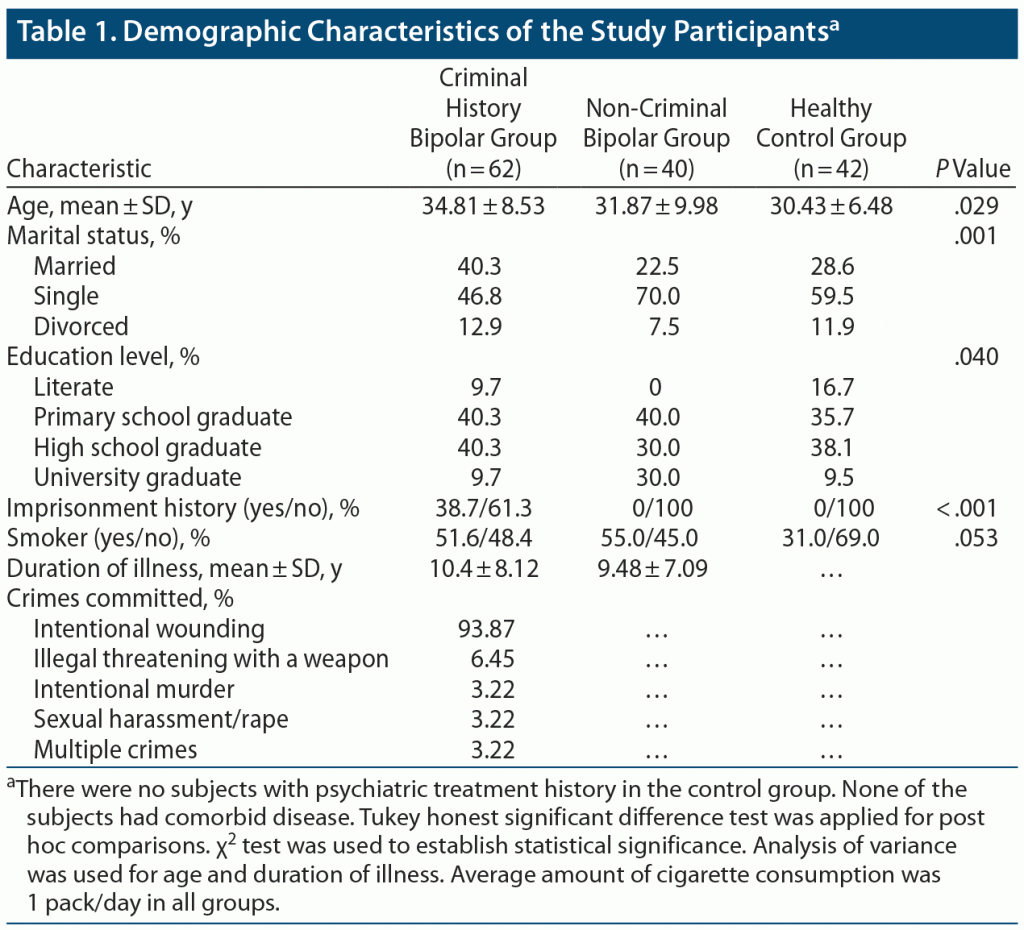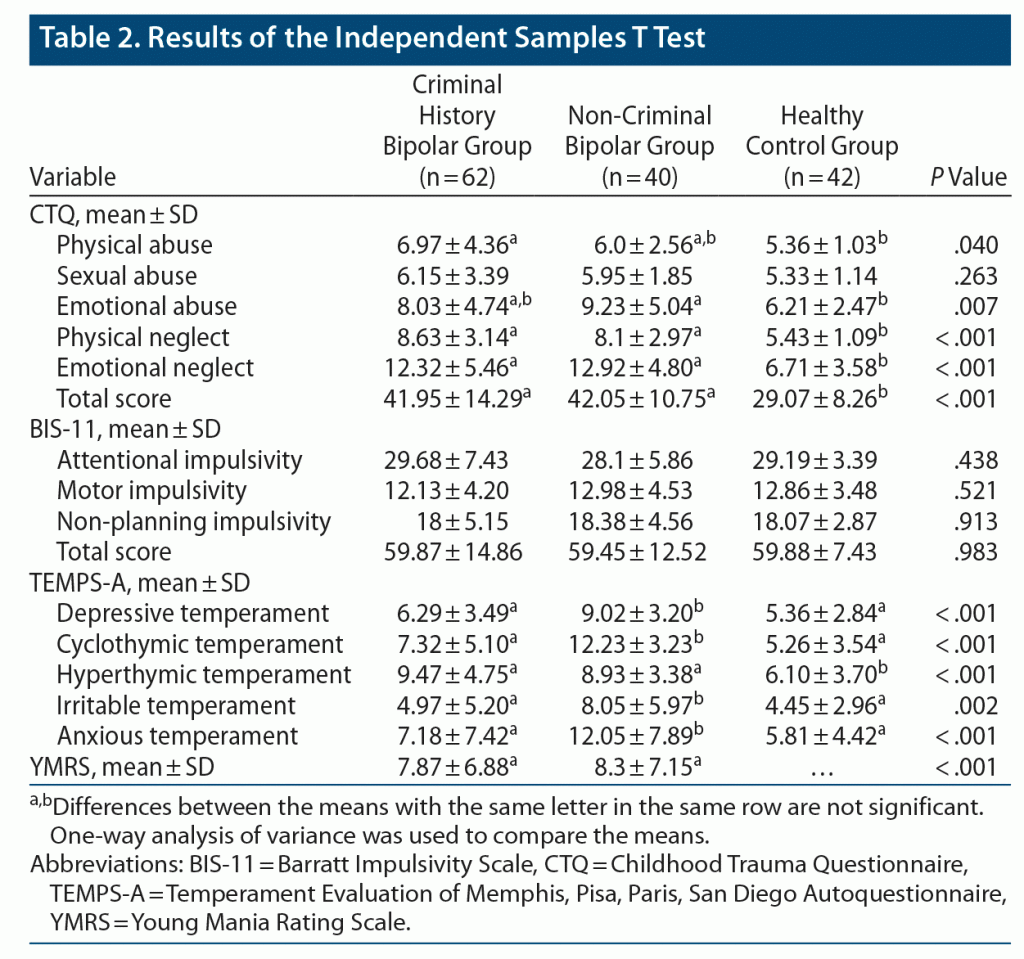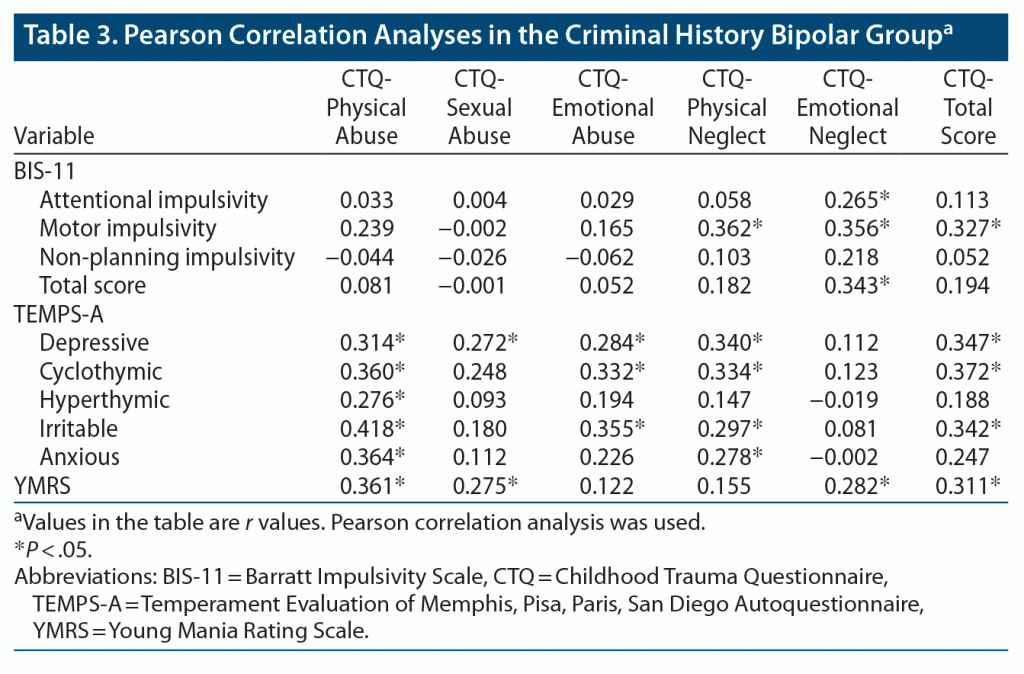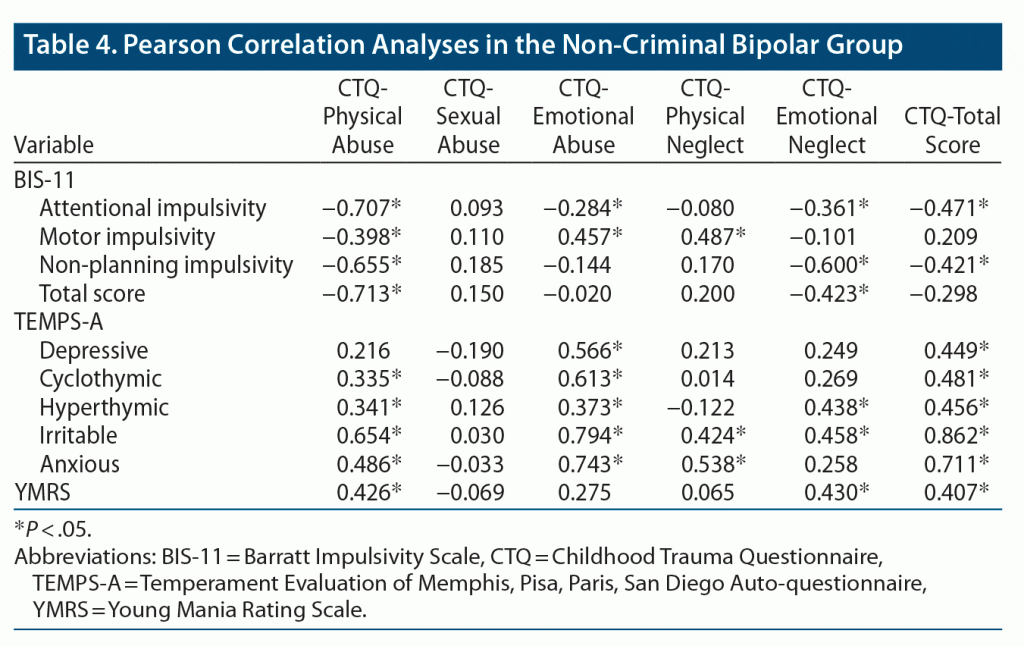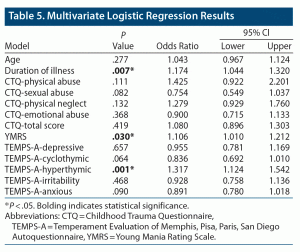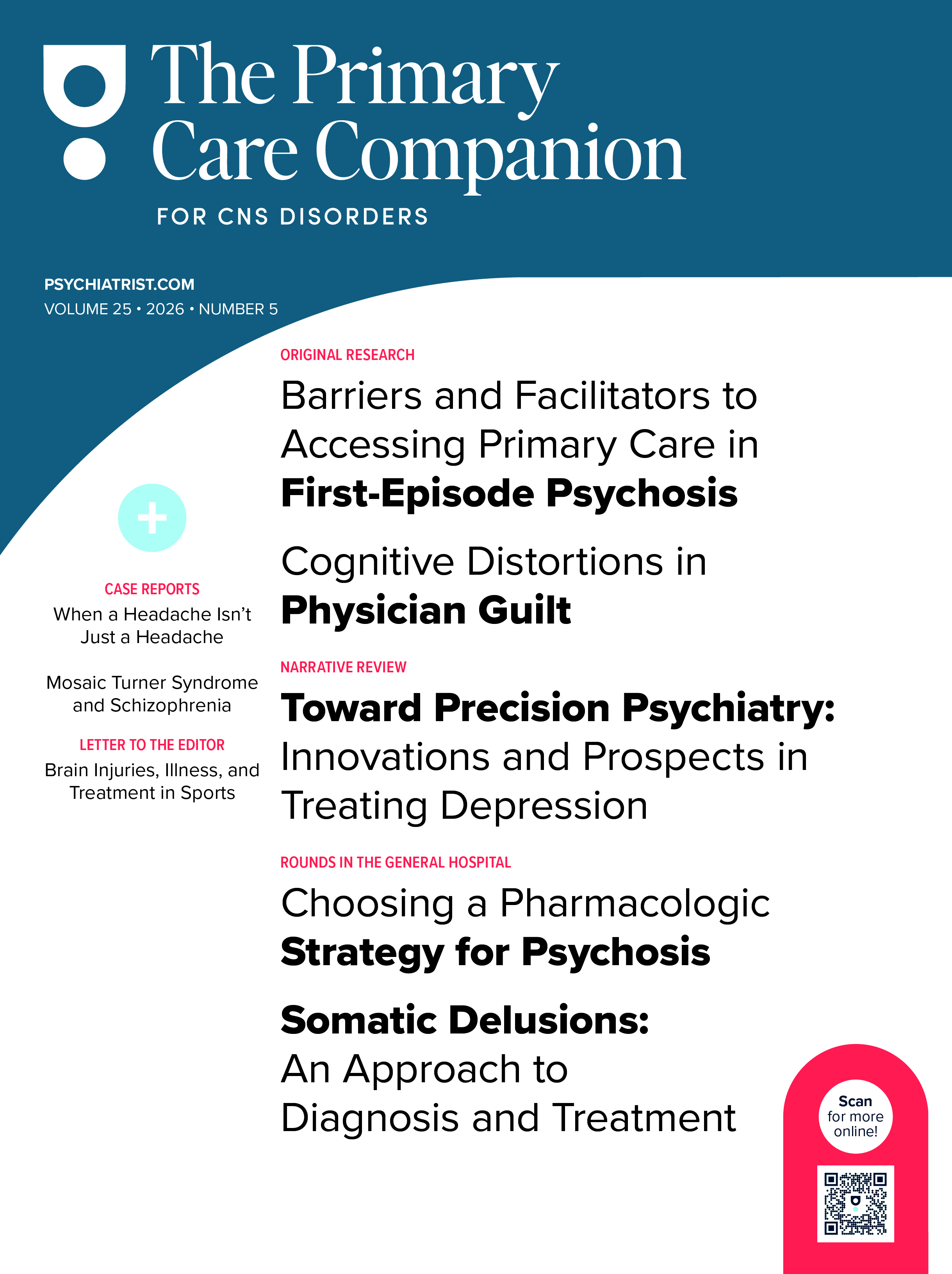ABSTRACT
Objective: To examine impulsivity, dominant temperaments, and childhood trauma in patients with bipolar I disorder who committed crimes by comparing them with bipolar I patients with no criminal history and with healthy controls.
Methods: A total of 144 subjects in 3 groups (62 criminal history bipolar patients, 40 non-criminal bipolar patients, and 42 controls) participated in this cross-sectional study. All participants completed the Childhood Trauma Questionnaire (CTQ), the Barratt Impulsiveness Scale (BIS-11), and the TEMPS-A (Temperament Evaluation of Memphis, Pisa, Paris, San Diego Autoquestionnaire). Subjects were enrolled in the study between April 1, 2019, and March 1, 2020.
Results: The mean age was higher (P = .029) and education level lower (P = .045) among the criminal history bipolar patients than the other 2 groups. Of quantitative variables, physical abuse and emotional abuse subscales and total CTQ score were significantly higher in both patient groups compared to healthy controls (P < .001 for all scores). For dominant temperament, hyperthymic temperament scores of the criminal history bipolar group were higher than that of the control group (P < .001).
Conclusions: Patients with bipolar I disorder were found to have experienced more childhood traumas, and the criminal history bipolar group and those who were admitted to prison had suffered more physical abuse. Hyperthymic temperament was dominant in bipolar I patients involved in crime. Taking into account the temperaments of bipolar I disorder in treatment plans and providing psychosocial support to these patients could help prevent violent behaviors and the possibility of crime.
Prim Care Companion CNS Disord 2022;24(4):21m03103
To cite: Özsoy F, Taşcı G, Atmaca M. Investigating the association of criminal behavior with childhood traumas, impulsivity, and dominant temperaments in bipolar I disorder. Prim Care Companion CNS Disord. 2022;24(4):21m03103.
To share: https://doi.org/10.4088/PCC.21m03103
© 2022 Physicians Postgraduate Press, Inc.
aDepartment of Psychiatry, Tokat State Hospital, Tokat, Turkey
bElazığ Fethi Sekin Education and Research Hospital, Elazığ, Turkey
cClinic of Psychiatry, Elazığ Fırat University School of Medicine, Elazığ, Turkey
*Corresponding author: Filiz Özsoy, MD, Clinic of Psychiatry, Yeni District, Tokat State Hospital, 60100 Center, Tokat, Turkey ([email protected]).
Violence is described as damaging, destructive behavior that could result in psychological damage, injury, or death.1 It is the basis of criminal behavior, which has detrimental effects on individuals and communities.2 Psychiatric diseases have been suggested for many years to be associated with violent behavior and criminality. It has even been reported that the risk of violent behavior increases in people with serious psychiatric diseases.3,4
Violent behavior does not increase in every psychiatric disease, but it is more common especially in psychiatric diseases such as bipolar disorder and schizophrenia.4 In other words, compared to the general population, people with psychiatric diseases are not more dangerous, but there is a dangerous subgroup in psychiatric diseases.5 Studies1,4,6 on psychiatric illnesses and crime are limited. In many of the available studies, psychiatric disease rates were investigated among people who committed crimes. A study6 with bipolar disorder patients found that the likelihood of violent behavior increased 3-fold compared to the population without psychiatric illness. This rate was reported to be 20 times higher when substance abuse was involved.6 In another study,7 mood disorders, alcohol-substance abuse, and personality disorders were found to be linked with violence. In addition, childhood traumas were reported to be risk factors for violent behavior and commitment of criminal acts by psychiatric patients.8–10
Child abuse is defined as the preventable behaviors, excluding accidents, by a child’s caregiver that could impair physical and psychosocial development of the child. Child abuse is a multidimensional phenomenon and is divided into 5 groups: emotional abuse, physical abuse, sexual abuse, emotional neglect, and physical neglect.11 Childhood traumas have been linked to the development of many psychiatric diseases such as depressive disorder, bipolar disorder, psychotic disorder, low self-esteem and suicidal thoughts, and personality pathologies.12–15 In addition, childhood traumas were also reported to be associated with pleasure and excitement seeking, attention deficit, and impulsive behaviors such as making sudden decisions, anger control problems, violence, and criminal tendency.15 Impulsivity is defined as an action or behavior that is done suddenly, quickly, without thinking about the end, and without making a plan. Although it is basically defined as a personality dimension, impulsivity is a complex concept with both behavioral and cognitive aspects.16 However, personality is formed by the merging of temperament and character. Temperament comprises structural properties that are genetically transmitted and undergo little change throughout life. Character is a result of adapting to changes through the effects of environmental factors, family, and education. Akiskal and Mallya17 reviewed the temperament concept and classified it as hyperthymic, cyclothymic, irritable, anxious, and depressive temperaments.
Studies examining the relationship between psychiatric disease and violent behavior in the literature are limited. In these studies,2–7 aggression and suicidal and homicidal behaviors were investigated in psychiatric diseases. In a limited number of studies4,7,9 on criminal behavior and psychiatric illnesses, parameters such as frequency of criminal behavior and characteristics of the crime were examined in schizophrenia patients. Studies1,18 dealing with the criminal behavior of patients with bipolar disorder are also very limited. Furthermore, there have been no studies, to the best of our knowledge, examining the temperaments, childhood traumas, and impulsivity levels of patients with bipolar disorder who had criminal involvement. The aim of the present study was to investigate the dominant temperaments, childhood traumas, and impulsivity levels of patients with bipolar I disorder with a criminal history by comparing them with bipolar I patients with no crime involvement and with healthy controls.
METHODS
This cross-sectional study used standardized scales of childhood trauma history, impulsivity, and temperament to compare 2 samples of patients with bipolar I disorder admitted to a psychiatric inpatient unit during the manic phase of illness (1 group with criminal records, 1 with no criminal history) and a comparison group of patients with no psychiatric or alcohol/substance abuse disorders. Subjects were enrolled in the study between April 1, 2019, and March 1, 2020. The study was approved by Tokat Gaziosmanpaşa University Non-Invasive Local Ethical Board and Provincial Health Management and was implemented in accordance with the Declaration of Helsinki.
Participants
All participants were informed about the study, and signed consent was obtained from those who were willing to participate. The study comprised 3 groups. The first group included inpatients with a bipolar I disorder diagnosis based on DSM-5 criteria who had committed crimes and were kept under observation or protected in the criminal psychiatry unit of Elazığ Fethi Sekin Town Hospital, while the second group included patients with bipolar I disorder who had not been involved in any criminal behavior. The third group included healthy controls with matching demographic characteristics such as age, sex, and education level with no diagnosis of psychiatric disorders.
Inclusion and Exclusion Criteria
The subjects who were willing to participate, literate, and able to provide written consent were included in the study. Subjects with low general health status, chronic liver disease, chronic kidney failure, chronic heart disease, mental impairment, alcohol/substance abuse, or unwilling to participate were excluded. Patients with bipolar disorder and depressive episodes were not included in the study. The healthy control group consisted of individuals who applied to the psychiatry outpatient clinic for general examination, job application, or military examination and consultation; had no psychiatric disease or alcohol/substance use according to DSM-5 criteria; and could match the patient group with demographic data.
For this study, 84 bipolar I patients who committed crimes (criminal history bipolar group) and 55 who had not been involved in criminal behavior (non-criminal bipolar group) were interviewed. Fifteen people in the criminal history bipolar group and 10 in the non-criminal bipolar group refused to participate in the study. Thus, 62 criminal history bipolar patients and 40 non-criminal bipolar patients met the inclusion criteria. In addition, 42 healthy controls with matching sociodemographic characteristics were also included.
Procedure
All participants signed a consent form and filled out the sociodemographic data form. Then, all participants completed the study scales. In the patient groups, the scales were administered approximately 1 week after hospitalization in the examination room of the psychiatry service after the acute manic episodes had partially subsided. In the healthy control group, the scales were completed in the psychometric test room of the psychiatry outpatient clinic after psychiatric and psychometric examinations.
Instruments
All participants completed the Childhood Trauma Questionnaire (CTQ), the Barratt Impulsiveness Scale (BIS-11), and the TEMPS-A temperament scale (Temperament Evaluation of Memphis, Pisa, Paris, San Diego Autoquestionnaire). Patients with bipolar I disorder also completed the Young Mania Rating Scale (YMRS).
The sociodemographic data form was prepared by the investigators based on the aims of the study. This form included questions about demographic variables such as age, place of residence, marital status, education level, and economic status, as well as questions about clinical and criminal information such as the duration of psychiatric disease, presence of psychiatric diseases in the family needing treatment, alcohol or tobacco use, and imprisonment history.
The CTQ was developed by Bernstein et al19 and was adapted to Turkish by Şar et al.20 It is a retrospective self-report scale evaluating the neglect and traumas experienced during childhood and adolescent periods. In the present study, the 28-question form of the scale was used. The scale has 5 subscales: physical abuse, emotional abuse, sexual abuse, physical neglect, and emotional neglect.
The BIS-11 is a 30-item self-report scale used to evaluate impulsivity. It consists of attentional (attention and cognitive instability), motor (motor and perseverance), and non-planning (self-control and cognitive complexity) components. The BIS-11 was developed by Patton et al16 and adapted to Turkish by Güleç et al.21 Higher total points indicate higher impulsivity levels.
The TEMPS-A was developed by Akiskal et al22 to evaluate variations in temperament. It is a self-reporting scale consisting of 100 questions to determine depressive, cyclothymic, hyperthymic, irritable, and anxious temperaments. Depressive temperament is assessed with 18 items, cyclothymic temperament with 19 items, hyperthymic temperament with 20 items, irritable temperament with 18 items, and anxious temperament with 24 items. The TEMPS-A scale was adapted to Turkish by Vahip et al.23
The YMRS24 was developed to evaluate the intensity and change of manic status and is filled out by the physician. Its validity and reliability in Turkish were confirmed by Karadağ.25
Statistical Analyses
Data were analyzed using SPSS software for Windows version 20. To provide information about the general characteristics of the participants, descriptive analyses such as frequency, percent distribution, and mean ± SD were calculated. Data from the continuous variables were expressed as mean ± SD, while data from the categorical variables were given as n (%).
Qualitative variables were demographic characteristics such as sex, age, education level, socioeconomic status, duration of psychiatric disease, presence of a psychiatric disease requiring treatment in someone else in the family, history of imprisonment, smoking, alcohol and/or any other substance use, and presence of additional medical conditions. Cross-table and χ2 tests were used to evaluate the relationship between qualitative variables. Data from the scales completed by the participants constituted the quantitative data in the study. Multivariate logistic regression analysis was performed to examine the effect of independent variables on the presence of the dependent variable. One-way variance analysis and significance test of the difference between the 2 means were used to evaluate the differences between the study groups for quantitative variables, and P < .05 was considered significant.
RESULTS
Participant Characteristics
The study included 102 patients with bipolar I disorder diagnosis and 42 healthy controls. The patients were grouped based on their involvement in criminal acts. The first group included 62 criminal history bipolar patients who were treated as inpatients or outpatients or under observation or protection, while the second group included 40 non-criminal bipolar patients. All participants were men. The mean ± SD age of the criminal history bipolar group was 34.81 ± 8.53 years, of the non-criminal bipolar group was 31.87 ± 9.98 years, and of the healthy control group was 30.43 ± 6.48 years. There were no significant differences among the study groups regarding marital, working, and socioeconomic status. In terms of education levels, 6 patients (9.7%) in the criminal history bipolar group were college graduates, while 12 (30%) of the non-criminal bipolar patients were university graduates (Table 1). Forensic files of the criminal history bipolar patients were sent to the investigators during the first examinations. In their files, the crimes in which they were involved were described in detail. Crimes committed by the patients in the criminal history bipolar group were intentional wounding in 52 patients (93.87%), illegal threatening with a weapon in 4 patients (6.45%), intentional murder in 2 patients (3.22%), and sexual harassment/rape in 2 patients (3.22%). Two patients (3.22%) were involved in multiple crimes such as illegal threatening with a weapon, wounding, kidnapping, or damaging someone else’s property. The number of smokers was 32 (52%) in the criminal history bipolar group, 22 (55%) in the non-criminal bipolar group, and 13 (31%) in the healthy control group. The average amount of cigarette consumption was 1 pack/day in both patient groups. There were no subjects with psychiatric treatment history in the control group. Fourteen patients in the criminal history bipolar group (23%) and 13 in the non-criminal bipolar group (32.5%) had history of psychiatric disease needing treatment among family members. None of the subjects had comorbid disease. The mean ± SD duration of bipolar I disorder was longer in the criminal history bipolar group (10.4 ± 8.12 years) compared to the non-criminal bipolar group (9.48 ± 7.09 years), and the difference was significant (P > .05).
Results of Bivariate Analyses
YMRS. There was no difference between the 2 patient groups on the YMRS (P > .05).
CTQ. Both patient groups had higher CTQ total score and CTQ physical neglect and emotional neglect subscale scores (P < .001 for all subscales). For the sexual abuse subscale, the scores of the patient groups were not significantly different from that of the healthy controls (P = .263). The physical abuse score of the criminal history bipolar group was higher than that of the healthy controls (P = .040).
BIS-11. The BIS-11 subscale and total scores were not significantly different in the patient groups compared to the healthy controls (P > .05).
TEMPS-A. In terms of dominant temperament, only the hyperthymic temperament score was significantly higher in the criminal history bipolar group compared to healthy controls (P < .001). Other temperament scores were not significantly different between the criminal history bipolar group and healthy controls (P > .05). Results of independent samples t test are provided in Table 2.
Results of Pearson Correlation Analysis
Pearson correlation analysis showed no association of attentional impulsivity and non-planning impulsivity scores and total score of the BIS-11 with the YMRS and TEMPS-A in the criminal history bipolar group. The motor impulsivity component of the BIS-11, on the other hand, had significant positive correlations with the YMRS and depressive, cyclothymic, irritable, and anxious temperaments of the TEMPS-A (r = 0.261, 0.329, 0.313, 0.353, 0.355, respectively) (Table 3). Duration of the disease in this group had positive association with only the emotional abuse subscale of the CTQ (r = 0.299).
Pearson correlation analyses of the non-criminal bipolar group are provided in Table 4. YMRS scores and attentional impulsivity component scores of the BIS-11 had a negative relationship (r = −0.329). The YMRS had a positive relationship with depressive, irritable, and anxious temperaments of the TEMPS-A (r = 0.360, 0.318, and 0.531, respectively). The anxious temperament score of the TEMPS-A had a negative relationship with the attentional impulsivity component of the BIS-11 (r = −0.391) and a positive strong relationship with the motor impulsivity component of the BIS-11 (r = 0.366). Non-planning impulsivity of the BIS-11 had negative associations with the depressive and irritable temperament subscales of the TEMPS-A (r = −0.326 and −0.347, respectively) (Table 4). Duration of the disease had strong positive associations with emotional abuse and emotional neglect subscales of the CTQ (r = 0.662 and 0.585, respectively). In addition, duration of the disease had strong positive relationships with the motor impulsivity component of the BIS-11 (r = 0.481) and depressive (r = 0.334) and anxious temperaments of the TEMPS-A (r = 0.514).
In multivariate logistic regression analysis, it was revealed that disease duration, YMRS, and TEMPS-A were significant predictors of hyperthymic temperament characteristics. In the non-criminal bipolar group, bipolar disorder increased the risk of being involved in crime 1.174 times in year of illness. In addition, crime involvement risk increased by 1.106 times and 1.317 times with 1 score increase of mania and hyperthymia scores, respectively. These results were statistically significant (Table 5).
Results for Patients With Imprisonment History
Twenty-four patients in the criminal history bipolar group (38.7%) had history of crimes requiring imprisonment, while no subjects in the other groups had a criminal record. Based on the significance test for the 2 means, only the physical neglect subscale score of the CTQ was significantly different between the groups with and without imprisonment history (P = .016). Also, the mean duration of the disease was significantly different between the group with (12.08 ± 9.14) and without (6.12 ± 7.32) imprisonment history (P = .001). Fourteen patients in the criminal history bipolar group (22.5%) had history of psychiatric disease requiring treatment in the family, compared to 13 patients (32.5%) in the non-criminal bipolar group. Patients in both groups with family members with a psychiatric disease requiring treatment had longer duration of disease and higher YMRS scores (P < .001). Scores for emotional abuse, physical neglect, and emotional neglect subscales and total points of the CTQ were higher in the patients with psychiatric disease in the family (P < .001). For the BIS-11, only the motor impulsivity component score was higher in patients with psychiatric disease history in the family (P = .001). Of dominant temperaments, depressive, cyclothymic, irritable, and anxious temperament scores were higher in the patient group with psychiatric disease history in the family (P = .003, P = .001, <.001, and < .001, respectively).
A subgrouping of all bipolar I patients based on smoking showed higher YMRS score in the smoking subgroup compared to the non-smoking subgroup (P = .054). The physical neglect subscale score of the CTQ was higher in the smoking subgroup (7.01 ± 4.44) than in the non-smoking subgroup (5.55 ± 1.39) (P = .007). The emotional neglect subscale score of the CTQ was 12.04 ± 5.59 in the smoking subgroup, which was significantly higher than that of the non-smoking subgroup (9.82 ± 95.16) (P = .014). The smoking subgroup also had significantly higher scores for cyclothymic, hyperthymic, and irritable temperaments of the TEMPS-A (P = .031, .014 and .022, respectively) compared to the non-smoking subgroup.
DISCUSSION
In the present study, childhood traumas, dominant temperament characteristics, and impulsivity levels of patients with bipolar I disorder with a criminal history were compared with both non-criminal bipolar I patients and healthy controls. The results showed that, irrespective of their crime involvement, bipolar I patients had experienced more childhood traumas than healthy controls. It was revealed that patients with an imprisonment history had experienced more physical neglect. In addition, the hyperthymic temperament was the dominant temperament in patients involved in crime.
YMRS scores in the patient groups with or without crime involvement were not significantly different. The mean YMRS score of patients with a bipolar I disorder diagnosis who were treated as inpatients due to “manic attack” in different geographical regions of Turkey was reported to be 33.2 ± 9.3.26 YMRS scores in the present study were low compared to that finding.26 In a study18 comparing the sociodemographic data of bipolar I patients involved in crime with those who were not, the patients were assessed during the remission period. Patients with YMRS scores of ≤ 5 were evaluated.18 Although we did not evaluate patients with bipolar I disorder during the remission period, YMRS scores of the patients (both bipolar I groups) were similar.
Scores of the physical and emotional neglect subscales and total scores of the CTQ were higher in the bipolar patient groups with or without crime involvement compared to healthy controls. The sexual abuse subscale scores of the patient groups were not significantly different from those of the healthy control group. The physical abuse score was high only in the criminal history bipolar group, and the emotional abuse score was high in the non-criminal bipolar group. Most studies27–30 of bipolar I disorder patients reported that patients experienced childhood traumas at least in 1 subscale. In a study30 of bipolar I patients in different countries, it was found that sexual abuse was prevalent. Poor prognosis and response to treatment and frequency of attacks in bipolar disorder were found to be associated with childhood traumas.27–30 In most studies27–29,31 of bipolar I patients, self-destructive behavior and aggression levels were associated with childhood traumas. No study in the literature, to our knowledge, compared patients with or without crime involvement for this aim. In the present study, physical neglect scores were higher in the criminal bipolar subgroup who had previous imprisonment history compared to other groups. In addition, scores of physical neglect and emotional neglect subscales and total trauma scores of the criminal history bipolar group had strong positive associations with motor impulsivity scores. These findings are in accordance with the literature.27–29,31 In the non-criminal bipolar group, on the other hand, emotional and physical abuse scores had strong positive associations with motor impulsivity, which is also in line with the literature. Impulsivity scores had negative correlations with physical abuse, emotional abuse, emotional neglect, and total trauma scores. This finding could be due to the differences in education level for these patients.
Epidemiologic studies29,32,33 showed that aggression and continuous anger levels of bipolar patients are higher than those of general society. Some studies2,29 even mentioned that continuous anger is the main characteristic of the disease. Impulsivity scores of bipolar patients in our study did not change based on their involvement in crime. This finding could be due to the evaluation tool used to measure impulsivity, starting treatment for the disease in all patients, or simply to higher impulsivity scores of the healthy control group.
The final finding of the present study was that no subjects in the healthy control group exceeded the threshold level for any temperament. In the criminal history bipolar group, on the other hand, 5 patients exceeded the threshold levels for depressive temperament, 3 patients for cyclothymic temperament, 7 patients for irritable temperament, and 7 patients for anxious temperament. In the non-criminal bipolar group, threshold levels were exceeded by 7 patients for depressive temperament, by 9 patients for irritable temperament, and by 7 patients for anxious temperament. These findings were similar for both bipolar patient groups. There are limited studies in the literature regarding violence and crime behaviors and dominant temperament of bipolar I disorder. Most of these studies34–37 examined suicide attempts rather than criminal behavior. In a study comparing the patients who did or did not attempt suicide, the hyperthymic temperament score was lower in those who attempted suicide.34 Similarly, we found higher hyperthymia scores in the crime-involved patient group compared to the group of patients not involved in crime and healthy controls. It could be stated that patients with hyperthymic temperaments have a tendency to harm the people around them, not themselves. A study35 investigating the relationship between childhood traumas and dominant temperament showed that all subtypes of childhood traumas had positive relationships with cyclothymic, depressive, irritable, and anxious temperaments. Only hyperthymic temperament had no relationship with childhood traumas. Violence and criminal behavior were not investigated in that study.35 Results of the present study were partly similar to those findings, and hyperthymic temperament was related only with the CTQ physical abuse subscale in the criminal history bipolar group. In the non-criminal bipolar group, hyperthymic temperament scores were related to physical abuse, emotional abuse, emotional neglect, and total trauma scores. Given our findings and reports in the literature, it could be stated that violent and criminal behavior could be estimated based on temperaments and experienced traumas.
Our study should be evaluated considering several limitations. The first limitation is the relatively small patient population. Second, follow-up of criminal history bipolar patients and the non-criminal bipolar group could not be carried out in the same hospital. Third, the study was sectional in nature and used self-report scales filled out by the patients, except for the YMRS. Fourth, only males were included in the study, the effects created by the behavior of the police during the arrest of patients involved in crimes were not taken into account, and patients were not evaluated in different disease periods (such as hypomania or depressive episode periods). Finally, failure to evaluate whether the patients attempted suicide could be considered a limitation. These limitations undermine the generalization of our findings and make their interpretation difficult. Studies with larger patient populations with and without crime involvement are needed.
In conclusion, irrespective of their crime involvement, patients with bipolar I disorder were found to have experienced more childhood traumas than healthy controls. It was revealed that patients with an imprisonment history had experienced more physical neglect. In addition, the hyperthymic temperament was the dominant temperament in patients involved in crime. Based on these findings, temperaments should be taken into account when planning treatment for bipolar patients. Also, it could be concluded that preventing the traumas suffered by children in their developmental years is crucial for sustaining the mental health of the community. In addition, psychosocial support for these patients and regular follow-up could help to eliminate violent behaviors and involvement in crime, thereby ensuring public safety.
Submitted: August 14, 2021; accepted December 28, 2021.
Published online: July 14, 2022.
Relevant financial relationships: None.
Funding/support: None.
ORCID: Filiz Özsoy: https://orcid.org/0000-0002-5198-8827; Gülay Taşcı: https://orcid.org/0000-0003-2078-0182
Clinical Points
- Aggressive behaviors toward themselves and others are quite common among patients with bipolar I disorder.
- Clinicians should consider that traumatic childhood events may underlie the aggressive behavior of bipolar I patients toward themselves and others, and these traumas should be carefully examined to prevent future criminal behaviors.
- Clinicians should consider the impulsivity and personality traits of bipolar I patients while planning their treatment.
References (37)

- Verdolini N, Pacchiarotti I, Köhler CA, et al. Violent criminal behavior in the context of bipolar disorder: systematic review and meta-analysis. J Affect Disord. 2018;239:161–170. PubMed CrossRef
- Látalová K. Bipolar disorder and aggression. Int J Clin Pract. 2009;63(6):889–899. PubMed CrossRef
- Latalova K, Kamaradova D, Prasko J. Suicide in bipolar disorder: a review. Psychiatr Danub. 2014;26(2):108–114. PubMed
- Schanda H, Stompe T, Ortwein-Swoboda G. Increasing criminality in patients with schizophrenia: fiction, logical consequence or avoidable side effect of the mental health reforms? Neuropsychiatr. 2010;24(3):170–181. PubMed
- İnan S, Yıldızhan E, Öncü F. The disease history, sociodemographics, and criminal features of the homicidal forensic psychiatric patients. Turk Psikiyatr Derg. 2018;29(4):258–268. PubMed CrossRef
- Fazel S, Grann M. Psychiatric morbidity among homicide offenders: a Swedish population study. Am J Psychiatry. 2004;161(11):2129–2131. PubMed CrossRef
- Coid J, Yang M, Roberts A, et al. Violence and psychiatric morbidity in a national household population: a report from the British Household Survey. Am J Epidemiol. 2006;164(12):1199–1208. PubMed CrossRef
- Sher L, Rice T; World Federation of Societies of Biological PsychiatryTask Force on Men’s Mental Health. Prevention of homicidal behaviour in men with psychiatric disorders. World J Biol Psychiatry. 2015;16(4):212–229. PubMed CrossRef
- Thapar A. Parents and genes and their effects on alcohol, drugs, and crime in triparental families. Am J Psychiatry. 2015;172(6):508–509. PubMed CrossRef
- Johnson KL, Desmarais SL, Grimm KJ, et al. Proximal risk factors for short-term community violence among adults with mental illnesses. Psychiatr Serv. 2016;67(7):771–778. PubMed CrossRef
- Yargıç İ, Ersoy E, Batmaz Oflaz S. The relation of childhood trauma with suicide attempt and self-mutilation. Anatolian J Psychiat. 2012;13:277–284 [Turkish].
- Mandelli L, Petrelli C, Serretti A. The role of specific early trauma in adult depression: a meta-analysis of published literature. Childhood trauma and adult depression. Eur Psychiatry. 2015;30(6):665–680. PubMed CrossRef
- Adigüzel V, Özdemir N, Şahin ŞK. Childhood traumas in euthymic bipolar disorder patients in Eastern Turkey and its relations with suicide risk and aggression. Nord J Psychiatry. 2019;73(8):490–496. PubMed CrossRef
- Barrigón ML, Diaz FJ, Gurpegui M, et al. Childhood trauma as a risk factor for psychosis: a sib-pair study. J Psychiatr Res. 2015;70:130–136. PubMed CrossRef
- Şen M. Psikolojik destek alan ve almayan bireylerde çocukluk çağı travmaları ve dürtüsellik ilişkisinin incelenmesi (Master’s thesis). Maltepe University, Sosyal Bilimler Enstitüsü, İstanbul, 2019:22.
- Patton JH, Stanford MS, Barratt ES. Factor structure of the Barratt Impulsiveness Scale. J Clin Psychol. 1995;51(6):768–774. PubMed CrossRef
- Akiskal HS, Mallya G. Criteria for the “soft” bipolar spectrum: treatment implications. Psychopharmacol Bull. 1987;23(1):68–73. PubMed
- Camcıoğlu TH, Oncü F, Şüküroğlu S, et al. The effect of the sociodemographic and the socioeconomic factors on criminal behavior of male patients with a bipolar I disorder. Turk Psikiyatr Derg. 2014;25(3):163–170. PubMed
- Bernstein DP, Fink L, Handelsman L, et al. Initial reliability and validity of a new retrospective measure of child abuse and neglect. Am J Psychiatry. 1994;151(8):1132–1136. PubMed CrossRef
- Şar V, Ozturk E, İkikardes E. Validity and reliability of the Turkish version of Childhood Trauma Questionnaire. Turkiye Klinikleri J Med Sci. 2012;32(4):1054–1063. CrossRef
- Güleç H, Tamam L, Güleç MY, et al. Psychometric properties of Turkish version of BIS-11. Bull Clin Psychopharm. 2008;18(4):251–258.
- Akiskal HS, Akiskal KK, Haykal RF, et al. TEMPS-A: progress towards validation of a self-rated clinical version of the Temperament Evaluation of the Memphis, Pisa, Paris, and San Diego Autoquestionnaire. J Affect Disord. 2005;85(1-2):3–16. PubMed CrossRef
- Vahip S, Kesebir S, Alkan M, et al. Affective temperaments in clinically-well subjects in Turkey: initial psychometric data on the TEMPS-A. J Affect Disord. 2005;85(1-2):113–125. PubMed CrossRef
- Young RC, Biggs JT, Ziegler VE, et al. A rating scale for mania: reliability, validity and sensitivity. Br J Psychiatry. 1978;133(5):429–435. PubMed CrossRef
- Karadağ F. Young mani değerlendirme ölçeğinin Türkçe çevirisinin güvenilirlik ve geçerlilik çalışması. J Turkish Psychiatry. 2002;13:107–114.
- Akkaya C, Altın M, Kora K, et al. Türkiye’de Bipolar I Bozukluğu Hastalarının, Sosyodemografik ve Klinik özellikleri-HOME Çalışması. Bulletin C Psychopharmacol. 2012;22(1):31–42. CrossRef
- Yılmaz O, Ateş MA, Başar SÜ, et al. Childhood traumas in patients with bipolar disorder: association with alexithymia and dissociative experiences. Anatolian J Psychiatr. 2016;17(3):188. CrossRef
- Aas M, Henry C, Andreassen OA, et al. The role of childhood trauma in bipolar disorders. Int J Bipolar Disord. 2016;4(1):2. PubMed CrossRef
- Nehir S, Irmak H, Demet MM, et al. Bipolar bozuklukta çocukluk çağı travmaları ve agresyon ilişkisi. Anatolian J Psychiatr. 2018;19(2):163–168.
- Maniglio R. Prevalence of child sexual abuse among adults and youths with bipolar disorder: a systematic review. Clin Psychol Rev. 2013;33(4):561–573. PubMed CrossRef
- Çakır S, Tasdelen Durak R, Özyıldırım I, et al. Childhood trauma and treatment outcome in bipolar disorder. J Trauma Dissociation. 2016;17(4):397–409. PubMed CrossRef
- Dutra SJ, Reeves EJ, Mauss IB, et al. Boiling at a different degree: an investigation of trait and state anger in remitted bipolar I disorder. J Affect Disord. 2014;168:37–43. PubMed CrossRef
- Ayhan Y, Akkaya Y, Çalı AE. Bipolar afektif bozuk-lukta güncel genetik bulgular. Türkiye Klinikleri. J Psychiatry Topics. 2013;6(2):1–13.
- Fico G, Caivano V, Zinno F, et al. Affective temperaments and clinical course of bipolar disorder: an exploratory study of differences among patients with and without a history of violent suicide attempts. Medicina (Kaunas). 2019;55(7):390. PubMed CrossRef
- Baldessarini RJ, Innamorati M, Erbuto D, et al. Differential associations of affective temperaments and diagnosis of major affective disorders with suicidal behavior. J Affect Disord. 2017;210:19–21. PubMed CrossRef
- Vázquez GH, Gonda X, Lolich M, et al. Suicidal risk and affective temperaments, evaluated with the TEMPS-A scale: a systematic review. Harv Rev Psychiatry. 2018;26(1):8–18. PubMed CrossRef
- Saito T, Toda H, Inoue T, et al. Relationship between the subtypes of child abuse and affective temperaments: comparison of depression and bipolar disorder patients and healthy controls using the reclassified Child Abuse and Trauma Scale. J Affect Disord. 2019;257:396–403. PubMed CrossRef
Please sign in or purchase this PDF for $40.
